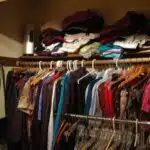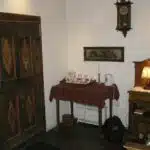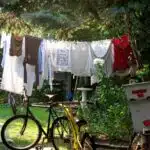Organizing a closet can be a daunting task, but it doesn’t have to be. With the right techniques, anyone can transform a cluttered closet into an organized oasis. One of the most effective ways to organize a closet is through color-coding. Not only does color-coding create a visually appealing closet, but it also makes finding and selecting outfits easier and quicker.
As a professional closet organization specialist, I have seen firsthand the benefits of color-coding. It not only saves time and reduces stress, but it also simplifies the decision-making process when it comes to getting dressed each day. By following some simple steps and tips, anyone can successfully color-code their closet and reap the benefits of an organized and efficient space. In this article, we will explore how to effectively color-code your closet according to various categories, as well as provide tips on maintaining your newly organized space.
Benefits Of Organizing Your Closet
Organizing your closet has numerous benefits that go beyond just having a neat and tidy space. One of the primary advantages is maximizing your closet space. Cluttered closets can make it difficult to see and access items, leading to frustration and wasted time searching for things. By organizing your closet, you can identify unused or underutilized areas and make the most of them. This might mean adding additional hanging rods or shelves, or using door organizers to store shoes or accessories.
In addition to maximizing space, organizing your closet also brings time efficiency benefits. When everything has a designated spot, it becomes easier to find what you need quickly without hunting through piles of clothes and accessories. With an organized closet, you’ll be able to get ready faster in the morning and avoid feeling rushed or stressed as you start your day.
Overall, taking the time to organize your closet is a worthwhile investment in both space utilization and time management. By creating a well-organized system for storing clothes and accessories, you’ll save yourself valuable minutes each day that can be spent on other activities. In the next section, we’ll discuss how to assess your current closet space so that you can create an effective organizational plan tailored to your specific needs.
Assessing Your Closet Space
When it comes to color-coding your closet, the first step is to assess your closet space. Measuring the available space in your closet is essential for deciding how much storage you need. Once you have measured the space, you can identify your storage needs.
Identifying storage needs involves evaluating what types of items you have and how much of each item you own. This evaluation helps determine what kind of storage solutions will work best for your closet. For example, if you have a lot of shoes, you may need a shoe rack or cubbies to keep them organized. If you have a lot of hanging clothes, you may need more hanging rods or hooks.
Overall, assessing your closet space and identifying your storage needs are crucial steps in organizing any closet, including color-coding it. By doing this first, you can ensure that your color-coded system works efficiently and effectively for your specific needs. Next, we will move on to decluttering your closet to prepare for the color-coding process.
Decluttering Your Closet
Organizing clothes can be accomplished by categorizing them into types and colors. Sorting shoes by type and season can help to ensure that they are kept in the most efficient way. Purging clothing requires a re-shelving and re-organizing of the closet to make the most effective use of the available space. Utilizing storage options such as hanging clothes and folding them can help create a capsule wardrobe and re-purpose clothes.
Organizing Clothes
Closet arrangement can be a challenging task, especially when it comes to organizing clothes. However, with a little effort and creativity, you can create a functional and visually appealing closet space. The first step in organizing clothes is to sort them by category. For instance, you can group all your pants together, all your shirts together, and so on. This will help you identify what you have and what you need.
Once you have sorted your clothes by category, the next step is clothing arrangement. One of the most effective ways to arrange clothes is to color-code them. Color-coding helps in creating an organized and visually pleasing closet space. You can group all your red clothes together, all your blue clothes together, and so on. This makes it easy for you to find what you are looking for quickly.
In conclusion, organizing a closet may seem like an overwhelming task but breaking it down into smaller steps makes the process more manageable. Closet arrangement involves sorting clothes by category followed by arranging them according to color code. A well-organized closet space not only makes it easier for you to find what you need but also adds aesthetic value to your home.
Categorizing Clothes
As a closet organization specialist, I understand that decluttering your closet can be a daunting task. However, it is an essential step towards creating a functional and visually appealing space. One of the most crucial steps in decluttering your closet is categorizing your clothes. This involves sorting them by type or season, such as separating pants from dresses or summer clothes from winter clothes.
Categorizing your clothes has many benefits. It makes it easier to find what you need quickly and saves time when getting dressed. You can also identify any duplicates or items you no longer wear, making it easier to decide what to keep and what to donate or sell. Additionally, categorizing clothes helps in arranging them in a way that maximizes storage space.
When categorizing your clothes, there are several tips to keep in mind. Firstly, group similar items together; for example, all pants go together, as do all shirts and so on. Secondly, consider the occasion or season for which each item is suitable when arranging them within each category. Lastly, separate out any specialized clothing items such as workout gear or formalwear.
In conclusion, categorizing your clothes is an essential step towards decluttering your closet and creating an organized space. It not only saves time but also maximizes storage space and helps identify any duplicates or unwanted items that can be sold/donated. By following the tips mentioned above and color-coding clothing categories further down the line (as we discussed earlier), you can create a well-organized closet that will serve you efficiently for years to come.
Sorting Your Clothes By Categories
As we have discussed in the previous section, decluttering your closet is the first step towards a more organized wardrobe. Now that you have purged unnecessary items, it’s time to categorize your clothes. This step will help you identify what type of clothing you own and how much you have of each category.
Organizing benefits are numerous when it comes to closet categories. First, it saves time when getting dressed in the morning since you know exactly where everything is located. Second, it makes it easier to maintain a clean and organized space. Third, categorizing enables one to create a capsule wardrobe or minimalist wardrobe by identifying duplicate items and determining what is essential.
When sorting your clothes by categories, consider grouping them into four main categories: tops, bottoms, dresses/jumpsuits/rompers, and outerwear. Each category can be further divided into subcategories such as sleeve length or fabric type. Once you have identified your categories, it’s time to move on to choosing your color-coding system for an even more efficient closet organization system.
Choosing Your Color-Coding System
Choosing the right colors for your closet can be a daunting task, especially when it comes to color-coding. However, it is important to choose colors that are easy to distinguish and visually appealing. When selecting colors, consider using a rainbow spectrum or selecting shades of the same color. This will ensure that you have a balanced and cohesive look.
The benefits of color coding extend beyond just organization. It can help reduce stress levels by providing visual cues that make it easier to find what you need quickly. Additionally, color-coding can help with decision-making by allowing you to easily see what items you have in each category and how many of each. This can also assist in identifying any duplicates or items that may no longer serve a purpose.
Creating a color-coding key is essential in making sure everyone in your household is on board with the system. A key will allow everyone to understand which color corresponds to each category. Be sure to clearly label each section of your closet with its corresponding color so there is no confusion. In the next section, we will discuss how to create a clear and concise color-coding key for your closet organization system.
Creating A Color-Coding Key
- When creating a color-coding key for a closet, it is important to select a color scheme that is visually pleasing and easy to remember.
- Assigning colors to categories of items in the closet helps to quickly identify where items belong and makes it easier to identify what is missing.
- For example, clothing items can be divided into warm colors (red, orange, yellow) and cool colors (green, blue, purple).
- For an effective color-coding system, labels should be created for each category of items and color so that users can easily and quickly locate what they are looking for.
- Labels should be placed in an easily visible and accessible location, such as on the inside of closet doors, for maximum efficiency.
- A color-coding system can provide an organized, efficient and aesthetically pleasing way to store and access items in a closet.
Choosing A Color Scheme
The process of creating a color scheme for a closet can be daunting, but with the help of color psychology and trends in fashion, it can become more manageable. Color psychology plays a significant role in determining which colors are best suited for different clothing items. For example, red is known to evoke passion and energy, making it an excellent choice for workout clothes. Meanwhile, blue represents calmness and stability, making it ideal for workwear. Therefore, selecting a color scheme that matches the intended emotion of each clothing item is crucial.
Fashion trends also play a vital role in choosing the right color scheme for a closet. Following the current fashion trends can ensure that the chosen colors are not only stylish but also relevant. For instance, pastel colors have been trending in recent years due to their subtle nature and versatility. Incorporating pastels into a closet’s color scheme can create a modern yet timeless look that will last through multiple fashion seasons.
In summary, choosing a color scheme requires careful consideration of both color psychology and fashion trends. By factoring in each clothing item’s intended emotion and following current fashion trends, one can create an aesthetically pleasing and functional closet that serves its purpose effectively.
Assigning Colors To Categories
Color coding is a useful tool when it comes to organizing a closet. Assigning colors to specific categories can make it easier to locate items quickly, especially when in a hurry. The color coding benefits are numerous, from reducing clutter to eliminating the need for extensive searching through piles of clothing. By creating a color-coding key, one can assign colors to different categories of clothing items, such as tops, pants, dresses, and accessories.
When assigning colors to each clothing category, it’s essential to consider color psychology in organization. For instance, blue is known for its calming effect and may be an ideal choice for sleepwear or lounge wear. Meanwhile, red is associated with energy and passion and may be suitable for athletic wear or workout clothes. By incorporating these principles into your color-coding system, you can create an organized closet that aligns with your needs and preferences.
Overall, assigning colors to categories is an effective way of organizing a closet that will save time and reduce stress. With the use of color psychology in organization and a well-planned color-coding key, finding specific items will become more accessible than ever before. Whether you’re dressing for work or leisure activities, having a well-organized closet can simplify your life immensely and transform your daily routine for the better.
Creating Labels
Now that we have discussed the benefits of color coding in organizing a closet, it’s time to delve deeper into creating a color-coding key. One important aspect of this process is designing and placing labels. Label design is crucial in ensuring that the categories are clear and easy to understand. It’s essential to choose label designs that are visually appealing and match the overall aesthetic of your closet. Additionally, using bold fonts and contrasting colors can make the labels stand out and easier to read.
Label placement is also critical in creating an organized closet. Placing labels on the outside of drawers or containers can help identify contents quickly without having to open them up. It’s also helpful to place labels at eye level, so they’re visible from afar. This way, you don’t have to search through piles of clothes or containers to find what you need.
Overall, creating labels is an important step in developing a functional color-coding system for your closet. By carefully designing and placing labels, you can ensure that everything is well-organized and easily accessible when you need it most. With a little effort and attention to detail, you can transform your closet into a stress-free space that supports your daily routine.
Color-Coding By Clothing Type
Now that you have created your color-coding key, it’s time to move on to the next step in organizing your closet – color-coding by clothing type. This technique involves grouping items of similar fabric and pattern together, making it easier to find what you need when getting dressed.
Color coding by fabric is an effective way to keep your closet in order. Grouping items made of the same material will help you avoid confusion and save time. For example, all cotton shirts can be placed together, while woolen items can be grouped separately. This method also helps preserve the quality of your clothes since similar fabrics require similar care when washing and drying.
Another approach is color coding by pattern. If you own a lot of printed clothing, this method will work well for you. Separating solids from prints makes it easier to coordinate outfits and prevents clashing patterns. You could group all striped or polka-dotted items together while keeping solid-colored clothing separate.
As a closet organization specialist, my goal is to make the process of selecting clothing as effortless as possible for my clients. By using these methods, you’ll be able to streamline your morning routine and reduce stress levels associated with getting dressed each day. In the next section, we’ll discuss how to take this one step further by color-coding by season.
Color-Coding By Season
When it comes to color-coding a closet, one effective method is to organize by season. This means separating your clothing items into categories that correspond with the different seasons of the year. By doing so, you can make it easier to find what you need when the weather changes.
Begin by removing all clothing items from your closet and sorting them into piles for each season. This will help you see which items are appropriate for each time of year and identify any duplicates or unnecessary pieces. For example, summer clothing might include shorts, tank tops, and sundresses, while winter clothing might consist of sweaters, jackets, and boots.
Once you have sorted your clothing items by season, consider how often you wear each piece. Year-round staples like jeans or basic t-shirts can be placed in a separate section of your closet to avoid confusion. Then, arrange your seasonal rotation in order of frequency of use. The more often an item is worn during a particular season should be placed at the front of that section.
By organizing your closet by season and frequency of use, you can save time in the morning when getting dressed and make sure that all of your clothing items are being utilized throughout the year. In the next section, we will discuss how to take color-coding a step further by organizing your clothes according to occasion.
Color-Coding By Occasion
- When organizing a closet for work, it is important to consider the colors and styles that are appropriate for the workplace.
- Special events, such as weddings or formal engagements, can be easily organized by color-coding the closet with items that are appropriate for the occasion.
- To create a casual wardrobe, it is important to use colors that can be easily mixed and matched and can be used for a variety of activities, such as going out with friends or staying in.
- By organizing the closet by occasion, it is possible to create an easily navigable wardrobe that is suitable for any occasion.
Organizing For Work
Are you struggling to get dressed for work in the morning? Organizing your closet by occasion can help alleviate the stress of choosing an outfit. Creating a capsule wardrobe for work is a great way to start. This means selecting a few versatile pieces that can be mixed and matched to create multiple outfits. Choose neutral colors such as black, gray, and navy, which are easy to pair with other items.
Maximizing small closet spaces can also be a challenge when organizing for work. One way to optimize space is by utilizing hanging organizers or shelves to store shoes, purses, and accessories. Consider using slim hangers instead of bulky ones to fit more clothing in your closet. Another tip is to fold pants and skirts vertically instead of horizontally, which saves space and makes it easier to see what you have.
Incorporating color-coding into your organization system can further simplify getting dressed for work. Arrange your clothes by color within each category (shirts, pants, dresses) so that you can easily find what you need without wasting time searching through your entire wardrobe. Use one color for work attire, such as black or blue, and another color for casual wear, like pink or green. This will not only make your closet look visually appealing but will also save you time in the morning when getting ready for work.
Remember that organizing your closet is an ongoing process and may take some time. However, with these tips on creating a capsule wardrobe, maximizing small spaces, and incorporating color-coding into your system, getting dressed for work will become a breeze!
Special Events
Color-coding by occasion is a highly effective way of organizing your closet and simplifying your outfit coordination. By arranging your clothes by color within each category, you can easily find what you need without wasting precious time searching through your entire wardrobe. This method not only helps you streamline your morning routine but also allows you to dress for success with ease.
When it comes to special events, color-coding takes on an added level of importance. Whether it’s a job interview, a business conference, or a formal gathering, dressing appropriately is crucial in making a good impression. Having a separate section in your closet for special event attire can help ensure that you have the right outfit on hand for any occasion. Consider using one color to represent formal wear and another for semi-formal attire.
To optimize space and make the most out of your special event section, consider creating a capsule wardrobe specifically for these occasions. Choose versatile pieces that can be mixed and matched to create multiple outfits. Select neutral colors such as black, navy, and gray that are easy to pair with other items. With this system in place, getting dressed for any special event will become stress-free and enjoyable!
Color-Coding By Style
Color-coding a closet is an effective way to organize clothing items based on their color. However, it is not limited to just color-coding by occasion or style. Another way to categorize clothes is by pattern. Separating patterns from solids and other prints can make it easier to mix and match colors within each category.
When color-coding by pattern, start with the dominant color in the garment. For example, if a shirt has stripes of blue and white, categorize it under blue. If a skirt has floral patterns with different colored petals, categorize it under the predominant color of the petals. This will help create a cohesive look when mixing and matching colors within each category.
Mixing and matching colors within each category can be done effortlessly with this system. Within each section of solid-colored clothing or patterned pieces, arrange them from lightest to darkest hues. This way, when creating an outfit, you can easily see which shades complement each other best.
With these techniques for color-coding a closet in mind, your wardrobe will become more organized and visually appealing. Next up, we’ll discuss effective clothing storage solutions that will help maximize space in your closet.
Clothing Storage Solutions
When it comes to clothing storage solutions, it’s important to consider the space you have available and how you can make the most of it. One effective way to do this is by color-coding your closet. Not only does it look visually appealing, but it also makes finding specific items easier.
To start color-coding your closet, begin by grouping your clothing items by color. This can be done for everything from shirts and pants to accessories like scarves and belts. Once you’ve grouped everything together, decide on a system for organizing them within each color group. You may choose to order them by item type or by shade, depending on what makes the most sense for you.
Creative labeling can also be helpful in keeping your closet organized. Labeling shelves or drawers with the names of specific clothing items or categories can help ensure that everything has a designated place and is easy to find. Additionally, space-saving hangers such as slimline hangers or cascading hooks can help maximize your closet space while keeping your clothes neat and organized.
Incorporating these strategies into your clothing storage routine can help make getting dressed in the morning a stress-free experience. But before deciding how to organize within each color group, it’s important to first determine whether hanging or folding is the best option for each item – which we’ll explore in the subsequent section.
Hanging Vs. Folding
When organizing a closet, one of the biggest decisions to make is whether to hang or fold items. Both methods have their pros and cons, and it ultimately comes down to personal preference and the specific items being stored. Maximizing closet space is key, so it’s important to understand the benefits and drawbacks of each option.
Hanging clothes can be a great way to keep them wrinkle-free and easily accessible. It also allows for more vertical storage space in a closet. However, hanging too many items can quickly lead to a cluttered and cramped feeling. Additionally, certain fabrics may stretch or lose their shape when hung for long periods of time.
Folding clothes can be ideal for items that are prone to wrinkling or stretching when hung. It also allows for more efficient use of horizontal space in a drawer or on shelves. However, folding can take up more space than hanging, making it difficult to store large quantities of items in a small closet. It’s important to consider both methods when organizing your closet and find the right balance between hanging and folding based on your needs.
| Hanging Pros | Hanging Cons | |
|---|---|---|
| Pros | Wrinkle-free | Cluttered feeling |
| Easy accessibility | Stretching/losing shape | |
| More vertical storage | ||
| Cons |
In conclusion, deciding whether to hang or fold clothing depends on various factors such as fabric type, available storage space, and personal preference. By utilizing both methods strategically, you can maximize your closet space while keeping your clothes organized and accessible. In the next section, we’ll discuss how incorporating accessories into your closet organization can further enhance its functionality.
Utilizing Closet Accessories
In addition to color-coding your closet, utilizing the right accessories can make all the difference in keeping it organized. One of the most important accessories for any closet is hangers. Instead of using mismatched hangers, invest in a set of uniform hangers to create a clean and cohesive look. Velvet hangers are a great option as they prevent clothes from slipping off and take up less space than traditional hangers.
Bins are another great accessory that can help keep your closet organized. Use them to store items such as hats, scarves, and purses. Clear bins with labels allow you to easily see what’s inside without having to rummage through everything. This will save you time when getting ready in the morning and ensure that you’re able to find what you need quickly.
Maximizing space with shelves and drawers is also key when organizing your closet. Install shelves above hanging rods to store items such as shoes or folded clothes. Drawers are great for storing undergarments, socks, and other small items that might get lost otherwise. By utilizing every inch of space in your closet, you’ll be able to keep everything neat and tidy.
Next up: Maintaining Your Color-Coded Closet
Maintaining Your Color-Coded Closet
Organizing Your Closet should begin by creating a plan for the space, determining what items are needed and what colors should be used. Storing Items Neatly and Avoiding Clutter can be done by making use of hangers, labeling items and keeping track of inventory. Utilizing Vertical Space will help make use of the space and can be done by adding shelves and racks. Establishing a Maintenance Schedule will help ensure the closet remains organized and up to date with items, colors and outfits.
Organizing Your Closet
Are you tired of spending precious minutes each morning sifting through your closet for the perfect outfit? Do you feel like your wardrobe is overwhelming and disorganized? As a closet organization specialist, I understand how frustrating this can be. But fear not, with a color-coded closet, you can maximize efficiency and streamline your wardrobe.
The first step in organizing your closet is to declutter. Get rid of any items that no longer fit or are out of style. This will make it easier to see what you have and prevent unnecessary clutter. Next, separate your clothing by color. Not only will this create a visually appealing display, but it will also make it easier to find specific pieces when getting dressed.
Once your clothing is sorted by color, take it a step further by grouping items within each color category. For example, group all tops together – blouses, t-shirts, sweaters – and then organize them by sleeve length or fabric type. This level of organization may seem excessive, but it will save you time and energy when putting outfits together in the future.
By following these steps and maintaining a color-coded closet, you can easily maximize efficiency and streamline your wardrobe. Say goodbye to the frustration of an overwhelming closet and hello to effortless mornings filled with stylish outfits.
Knowing What Colors To Use
Now that you have successfully organized your closet by color, it is important to maintain it. One way to do this is by knowing what colors to use. Color theory and psychology of color play a crucial role in fashion, as certain colors can evoke specific emotions and moods. For example, blue is often associated with calmness and tranquility, while red is associated with passion and energy.
When selecting which colors to incorporate into your wardrobe, consider the season and occasion. Brighter hues may be more appropriate for spring and summer, while darker shades are suitable for fall and winter. Additionally, certain events may call for specific color choices. For example, job interviews may require more neutral or conservative colors.
It is also important to consider your personal preferences when choosing colors for your wardrobe. While following trends can be fun, it is ultimately up to you to decide what makes you feel confident and comfortable. By understanding the nuances of color theory and psychology of color while also considering your own preferences, you can make informed decisions when maintaining your color-coded closet.
Troubleshooting Common Organizational Issues
Maintaining a color-coded closet can be an effortless way to simplify organization and maximize space. However, it is important to note that the initial process of color coding may require some time and effort. Once completed, though, it will save you plenty of time in the long run.
To color-code your closet effectively, start with sorting your clothing items by category. For example, group all your shirts together, then arrange them by color from lightest to darkest. Next, do the same for pants, skirts or dresses, and so on. This method allows you to easily locate specific items and also visually creates a cohesive look in your closet.
It’s also essential to take advantage of all available space when organizing a color-coded closet. Utilize hangers that are slim but sturdy to hang more clothes without overcrowding the space. Additionally, consider using shelf dividers or storage bins for folded items such as sweaters or jeans. With these tips in mind, maintaining a color-coded closet can be both efficient and aesthetically pleasing.
Conclusion
The benefits of organizing your closet are numerous. Not only does it save you time when getting dressed, but it also helps reduce stress and anxiety associated with cluttered spaces. Assessing your closet space is the first step in creating an organized system that works for you. Decluttering is a crucial part of achieving a functional and visually pleasing closet. Sorting your clothes by categories and color-coding them will make finding items easier and faster.
Choosing a color-coding system can be overwhelming, but it doesn’t have to be complicated. Whether you prefer to sort by color, season or occasion, the key is consistency. Utilizing closet accessories such as hangers, hooks, and shelves can maximize your storage space and create a more efficient system. Maintaining your color-coded closet requires regular upkeep, but it’s worth the effort.
As a professional organizer, I’ve seen firsthand the impact an organized closet can have on someone’s life. Not only does it free up physical space in your home, but it also creates mental clarity and reduces stress. Imagine waking up each morning to a neatly organized closet where everything has its place – that feeling of calm and order is priceless. Don’t let clutter control your life any longer – take charge of your closet today!
Image Credits
- “Skeleton in the Closet” by Bennilover (featured)

























![How To Wash And Care For White Clothes 25 The only genuine borax soap cleanses hygienically saves the clothes and hands. 20 Mule-Team brand Boraxo white laundry soap [front]](https://green-life.blog/wp-content/uploads/2023/05/YDXLLCovnOjq-150x150.jpg.webp)



